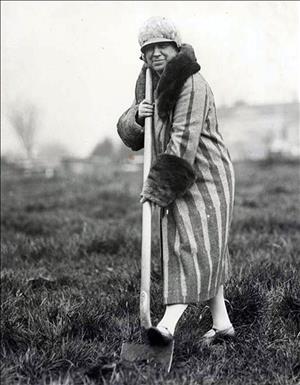On January 17, 2002, Mayor Greg Nickels (b. 1955), philanthropist Craig McCaw, and other dignitaries preside at the display of the contents of a time capsule first sealed on May 18, 1928, in the Civic Center. (This capsule was opened and resealed on April 9, 1962, to mark the Auditorium’s conversion into the Seattle Center Opera House.) Demolition begins to convert the Opera House into Marion Oliver McCaw Hall for the Seattle Opera, Pacific Northwest Ballet, and other performing arts groups and community events.
House that Suds Built
The funding for a future Civic Auditorium began with a bequest to Seattle by Pioneer Square saloonkeeper James Osborne, who died in 1881. He left $20,000 to the city government for a “civic hall,” if matched with other funds. The gift was deposited in trust and grew to $109,000, when Seattle allocated another $900,000 to build a Civic Auditorium in 1925. Local wags joked that it was “the house that suds built.”
Seattle’s first woman mayor, Bertha K. Landes (1868-1943), was a major booster of the project. The city selected a site nearly atop the original “Potlatch Meadows” homestead of pioneers David and Louisa Boren. Louisa was known as the Sweetbriar Bride for the roses she cultivated on the future site of Seattle Center. The new reinforced-concrete auditorium was designed by Seattle architects James Hansen Schack, Arrigo M. Young, and David J. Myers, who also created the nearby Civic Arena and Veteran’s Hall.
Cultural Dustbin?
Ironically, voters had already ousted Landes by the time the Civic Auditorium’s memorial time capsule was sealed on May 18, 1928. The hall became a center for musical performances, community ceremonies, and not a few public controversies. Many believe that its reportedly atrocious acoustics drove Seattle Symphony Orchestra conductor Sir Thomas Beecham to warn Seattle that it was heading for a “cultural dustbin” in the early 1940s. A decade later, the City Council tried to ban performer Paul Robeson and other leftwing artists and intellectuals from using the hall.
In preparation for the 1962 “Century 21” World’s Fair, the Civic Auditorium was gutted and given a modern brick facade by architect James J. Chiarelli, in consultation with legendary theater designer B. Marcus Priteca (1889-1971). The original 1928 time capsule was briefly unsealed on April 9, 1962, for the addition of new material. The revamped hall served for nearly four decades as home of a revitalized Seattle Symphony and new Seattle Opera and Pacific Northwest Ballet companies, but no amount of remodeling could disguise its inadequacies and accelerating deterioration.
Beyond Century 21
Under the leadership of Mayor Paul Schell, plans were drawn up to rebuild the Opera House as part of a package of other Seattle Center improvements and new community centers. On November 2, 1999, Seattle voters approved $72 million in bonds, including $38 million dedicated to the Opera House, in anticipation of an additional $90 million in private and community contributions.
The former Arena was remodeled to become the Mercer Arts Arena so it could serve as an interim home for the Opera and Ballet during reconstruction of the Opera House. The new hall was be named for Marion Oliver McCaw Hall in appreciation of a generous donation by her son Craig, a notable telecommunications entrepreneur.
Seeds From the Past
Construction of the new hall was officially launched on January 17, 2002. At that time, the 1928-1962 time capsule was opened to reveal the following contents, which were conserved and catalogued by the staff of the Museum of History & Industry:
1928 Time Capsule contents:
- Small letter box with a rose on the cover containing sweetbriar seeds from Louisa Boren Denny's garden.
- Photostat copy of the September, 1851 letter from David Denny to his brother Arthur Denny who was in Portland. The letter urged him to "...come as soon as you can," and noted that there was room for over a thousand families.
- Portrait of Louisa Boren Denny.
- Map, dated April 16, 1889, of David Denny's Home Addition, which deeded land to the city. The location of the Civic Auditorium was drawn in.
- Photos of the National Guard Armory on Union Street, and Yesler's Pavilion on 1st Avenue and Cherry Street.
- Drawing of Henry Yesler's cookhouse, built in 1852 and destroyed by fire in 1866.
- Typed speech given by Mayor Bertha K. Landes on May 18, 1928, for the dedication of the cornerstone.
- Copy of dedication prayer.
- Memorial half dollar in an envelope from the Oregon Memorial Trail Association.
- Seattle annual report by Mayor Bertha K. Landes, dated June 6, 1927.
- City of Seattle department head list.
- Specifications for Civic Auditorium project, including Civic Arena (now Mercer Arts Arena) and Civic Field (now Memorial Stadium).
- Envelope with photo and newspaper clippings of a worker who died during construction of the Civic Auditorium.
- Ordinances from the City of Seattle to submit the bond of $900,000 for the Civic Auditorium and the subsequent ordinance to ratify the loan for the project.
- Seattle Post-Intelligencer, May 18, 1928.
- Seattle Daily Times, May 18, 1928.
- The Seattle Star, May 18, 1928.
- Daily Journal of Commerce, May 18, 1928, and October 13, 1927 (which noted the call for bids).
- Pioneer Seattle and its Pioneers by Clarence B. Bagley.
- Blazing the Way by Emily Inez Denny, copyright 1899, published 1909.
1962 Time Capsule Contents:
- Envelope with one World's Fair Trade Dollar.
- Invitation to April 21, 1962 Opera House dedication ceremony.
- Seattle Daily Times, April 9, 1962.
- Seattle Post-Intelligencer, April 9, 1962.
- Daily Journal of Commerce, April 9, 1962.
- Folder with a letter from each of the City of Seattle Departments, dated 1962. Each letter describes the department's concerns at the time and their hopes for the future.

